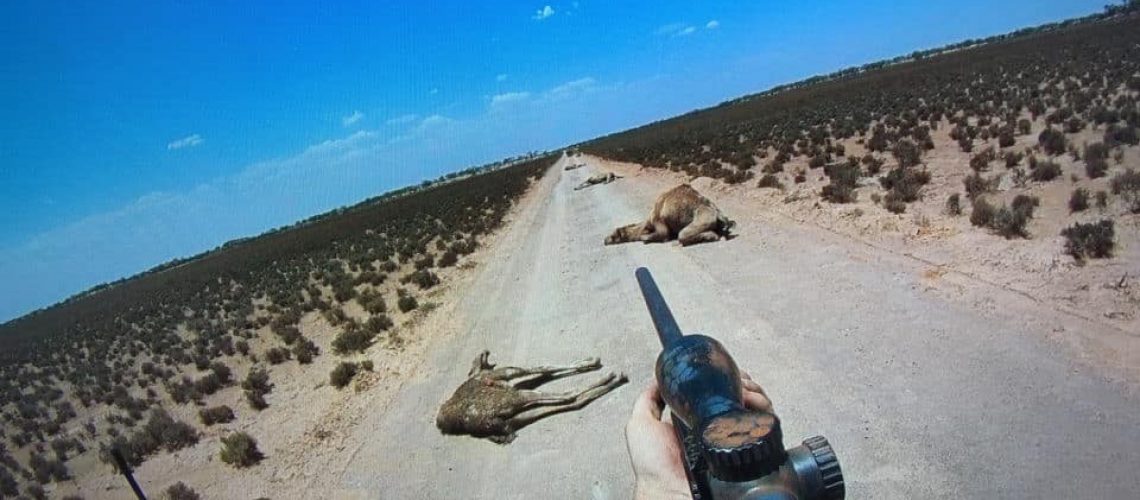Last year we had reports of camels trundling through crops near Esperance, this year we have them coming out of the desert into the rangelands driven by drought. On the surveys that have been completed there are up to 400,000 horses, 1.2 million camels, and 5 million donkeys wandering wild across Australia. Of these numbers up to a third are in Western Australia and their numbers are capable of doubling with a run of eight good years, just as they can die in vast numbers under miserable circumstances in a run of droughts. Or as the camels are currently doing head out of the desert in droves looking for water and grass in the state’s pastoral regions.
The logical solution is to go and shoot them and keep their numbers under control, but this costs money and at $10,000 a day for a helicopter it becomes something that quickly falls down the priority list of projects that a government wants to fund. In addition, it is not a good look for image conscious Premiers to call for culls just as Barnett found with his shark program. The western suburbs are quick to dial up the Sea Shepherd or the RSPCA when they see animals killed by the state.
Instead these community elites would prefer government to close their eyes to the real world reality of sharks eating humans or feral animals eating native vegetation, instead they look for simplistic solutions, or demand government focus on other global problems like climate change.
Which is exactly what the government is doing. Just last month the government announced another million dollars for an additional 5000 shark deterrent devices at $200 a throw. They also rolled out $5.5m for a Future Battery Cooperative Research Centre, $10m into the Renewable Hydrogen Fund and $3.75m for the Wave Energy Research Fund. This tells us they have plenty of money to burn so long as it is on trendy projects and even trendier solutions. In the mean time there is next to no money to address a long standing environmental problem which does not need a research centre to come up with the solution.
History tells us that neither side of politics has a good track record when it comes to controlling feral animals. The last government agonised for years before embarking on a cull of 11,000 horses at Lake Gregory, a cull that should have started years earlier. Instead both parties prefer to off load the problem onto the pastoralists, with the government standing back without having to get blood on their hands.
What we need is a new approach to feral animal control starting with establishing a dedicated Feral Animal Control Agency that is responsible for the hunting and killing of these invaders. A dedicated statutory authority similar to the Perth Zoo with a board of indigenous land owners, pastoralists and biosecurity specialists that instead of breeding and protecting endangered animals, their sole job would be to coordinate the efficient and humane eradication of these unwanted pests.
The funding should come from allocating the full amount of the pastoral lease fees that the state receives directly to this new agency. It would be far better for those funds to be reinvested back into projects that protect the states native flora and fauna than to see it spent on yet another research centre addressing global warming.
With just 435 pastoral stations, and even less operating on the front line of the current camel invasion, it is unfair for the state to expect them all to be on the firing line, week in week out holding the tide of the invading species. It’s a war zone out there and we need many more troops to drill down the number of these animals with a concerted effort over the next decade.
The government should give serious consideration to a private members bill that the Shooter’s, Fishers and Farmers Party will soon introduce that will allow qualified recreational shooters to hunt on crown lands. With thousands of amateur shooters prepared to spend their time and money on addressing an environmental problem, we should be making it as easy as possible for them to join the fight. No doubt the RSPCA will oppose any such move, but what is the difference between a departmental officer pulling the trigger versus a qualified recreational shooter, other than about $100 an hour in costs to the taxpayer.
Added to this change let’s reintroduce a bounty into the feral animal control equation. Feral bounty hunters will come from the professional and amateur shooters who have been trained and licensed by the government to work with the pastoral lease holders.
We have tried it before with the wild dog bounty established by former Minister for Agriculture Ken Baston back in 2013. The $75,000 program at a $100 a head cleaned up 500 dogs which if left to roam free would have maimed and killed thousands of sheep and native animals. Predictably the bounty was opposed by the RSPCA, but like many in the western suburbs they tend to have a head in the sand approach to the reality of what happens in the real world and the pain and suffering that these dogs are capable of inflicting.
So let’s use this latest invasion as a trigger to commence an ongoing $200 camel, horse and donkey bounty hunt. Once they are under control we can start on the millions of feral pigs, dogs, cats and foxes across Western Australia, so there is plenty of work to do. If we can afford to spend $20m funding battery, hydrogen and wave research centres that are all about decarbonising the future, the government can afford to spend $20m to decarbonise the feral camels in the bush and leave the bush to continue to put carbon in the ground.











